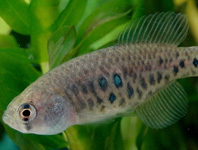Abstract
Styracaster yapensis sp. nov. is reported from the Yap Trench in the western Pacific from hadal depths between 6377–6575 m, which is among the deepest known occurrence of a species in this genus. It is distinguished from other Styracaster species by its abactinal surface armature and rudimentary cribriform organs. This paper provides a description of the new species along with detailed photos. The intraspecific differences between the holotype and paratype of the new species are examined with molecular and morphological approaches.
References
Belyaev, G.M. (1969) New sea stars from the abyssal and ultraabyssal Pacific. Byulleten Moskowskogo Obchestva Ispitatelei Prirody, Otdelenie Biologicheskoye, 74 (3), 5–25. [in Russian with English abstract]
Belyaev, G.M. (1985) New records of ultra-abyssal starfishes of the family Porcellanasteridae. Zoologychsky Zhurnal, 64 (4), 538–548. [in Russian with English abstract]
Belyaev, G.M. & Moskalev, L.I. (1986a) Starfishes of the genus Styracaster (Porcellanasteridae). 1. S. longispinus sp. n. from the group of long-ray species. Zoologichesky Zhurnal, 65 (5), 771–779. [in Russian]
Belyaev, G.M. & Moskalev, L.I. (1986b) Starfishes of the genus Styracaster (Porcellanasteridae). 2. New and rare short-armed species. Zoologichesky Zhurnal, 65 (6), 867–877. [in Russian]
Belyaev, G.M. & Moskalev, L.I. (1986c) Starfishes of the genus Styracaster (Porcellanasteridae). 3. The composition and geographic and vertical distribution. Zoologichesky Zhurnal, 65 (7), 1015–1023. [in Russian]
Clark, H.L. (1920) Asteroidea (Repports on the scientific results of the expedition to the tropical Pacific). Memoirs of the Museum of Comparative Zoology, 39 (3), 73–113.
Dilman, A.B. (2014) Deep-sea fauna of European seas: An annotated species check-list of benthic invertebrates living deeper than 2000 m in the seas bordering Europe: Asteroidea. Invertebrate Zoology, 11 (1), 25–42.
Folmer, O., Black, M., Hoeh, W., Lutz, R. & Vrijenhoek, R. (1994) DNA primers for amplification of mitochondrial cytochrome c oxidase subunit I from diverse metazoan invertebrates. Molecular Marine Biology, 3, 5294–5299.
Foltz, D.W., Bolton, M.T., Kelley, S.P., Kelley, B.D. & Nguyen, A.T. (2007) Combined mitochondrial and nuclear sequences support the monophyly of forcipulatacean sea stars. Molecular Phylogenetics & Evolution, 43 (2), 627.
https://doi.org/10.1016/j.ympev.2006.10.012Giribet, G., Carranza, S., Baguna, J., Riutort, M. & Ribera, C. (1996) First molecular evidence for the existence of a Tardigrada+ Arthropoda clade. Molecular Biology and Evolution, 13 (1), 76–84.
https://doi.org/10.1093/oxfordjournals.molbev.a025573Kimura, M. (1980) A simple method of estimating evolutionary rate of base substitutions through comparative studies of nucleotide sequences. Journal of Molecular Evolution, 16, 111–120.
https://doi.org/10.1007/BF01731581
Ludwig, H. (1907) Diagnosen neuer Tiefsee Seesterne aus der Familie der Porcellanasteriden. Zoologischer Anzeiger, 31 (9), 312–319. [in Germany]
Madsen, F.J. (1961) The Porcellanasteridae. A monographic revision of an abyssal group of sea-stars. Galathea Report, 4, 33–174.
Madsen, F.J. (1981) Records of a porcellanasterid, Styracaster elongatus (Echinodermata, Asteroidea), from the Caribbean, with remarks on growth and notes on some other species of the genus. Steenstrupia, 7 (14), 309–319.
Mah, C. & Hansson, H. (2014) Styracaster Sladen, 1883. In: Mah, C.L. (2017), World Asteroidea database. Accessed through: World Register of Marine Species. Available from: http://www.marinespecies.org/aphia.php?p=taxdetails&id=123269 (accessed 29 July 2017)
Mironov, A.N., Dilman, A.B., Vladychenskaya, I.P. & Petrov, N.B. (2016) Adaptive strategy of the porcellanasterid sea stars. Biology Bulletin, 43 (6), 503–516.
https://doi.org/10.1134/S106235901606011XPetrov, N.B., Vladychenskaya, I.P., DilMan, A.B. & Mironov, A.N. (2016) Taxonomic position of the family Porcellanasteridae within the class Asteroidea. Biology Bulletin, 43 (6), 483–490.
https://doi.org/10.1134/s1062359016060133Sladen, W.P. (1883) The Asteroidea of H.M.S. “Challenger” Expedition—Part II. Journal of the Linnean Society of London, Zoology, 17, 214–269.
https://doi.org/10.1111/j.1096-3642.1883.tb02022.xSmith, M.J., Arndt, A., Gorski, S. & Fajber, E. (1993) The phylogeny of echinoderm classes based on mitochondrial gene arrangements. Journal of Molecular Evolution, 36, 545–554.
https://doi.org/10.1007/BF00556359Tamura, K., Stecher, G., Peterson, D., Filipski, A. & Kumar, S. (2013) Mega6: molecular evolutionary genetics analysis version 6.0. Molecular Biology & Evolution, 30 (12), 2725–2729.
https://doi.org/10.1093/molbev/mst197
Thomson, C.W. (1877) The voyage of the "Challenger": the Atlantic. Vol. 1. Macmillan, London, 391 pp.
Ward, R.D., Holmes, B.H. & O'Hara, T.D. (2008) DNA barcoding discriminates echinoderm species. Molecular Ecology Resources, 8 (6), 1202–1211.
https://doi.org/10.1111/j.1755-0998.2008.02332.xWilliams, S.T. (2000) Species boundaries in the starfish genus Linckia. Marine Biology, 136 (1), 137–148.
https://doi.org/10.1007/s002270050016
Wood-Mason, J. & Alcock, A. (1891) LII. Natural history notes from H. M. Indian marine survey Steamer "Investigator". Series II, No. 1. On the results of deep-sea dredging during the season 1890–91. Annals and Magazine of Natural History, Series 6, 8 (48), 427–452.
https://doi.org/10.1080/00222939109459221Zulliger, D.E. & Lessios, H.A. (2010) Phylogenetic relationships in the genus Astropecten gray (Paxillosida: Astropectinidae) on a global scale: molecular evidence for morphological convergence, species-complexes and possible cryptic speciation. Zootaxa, 2010 (2504), 1–19.

